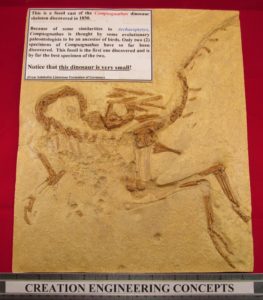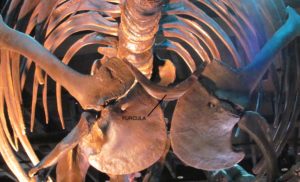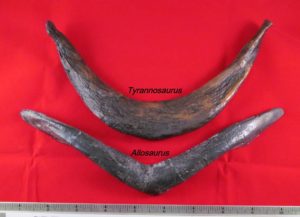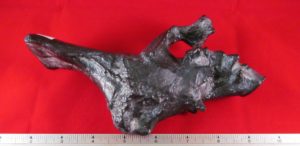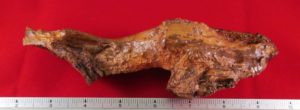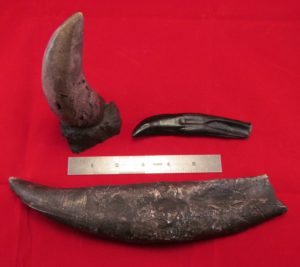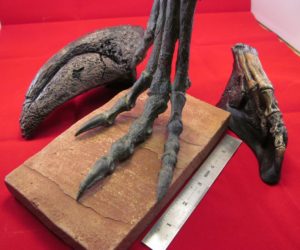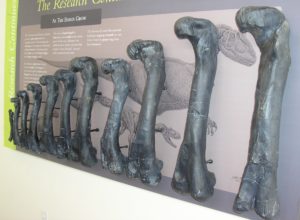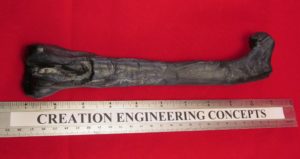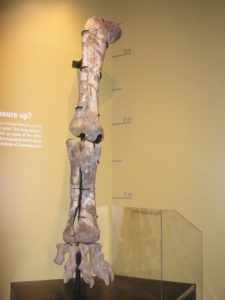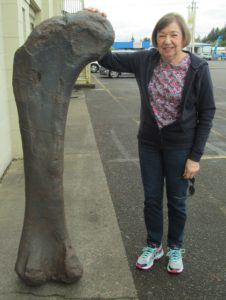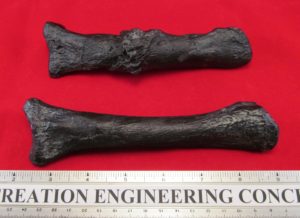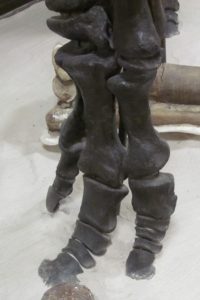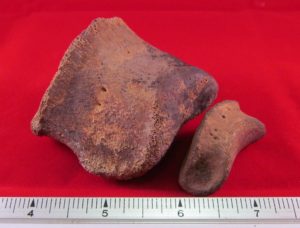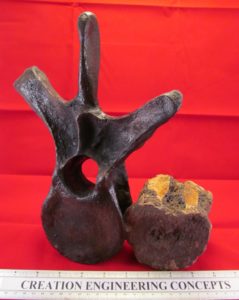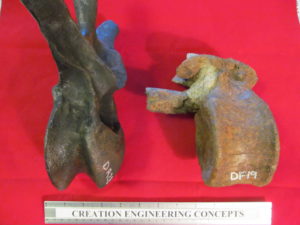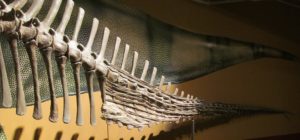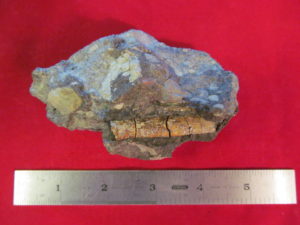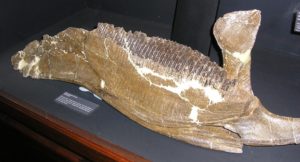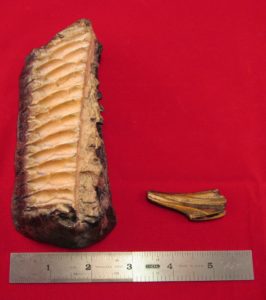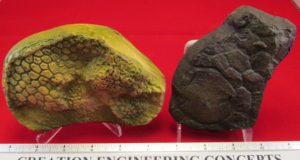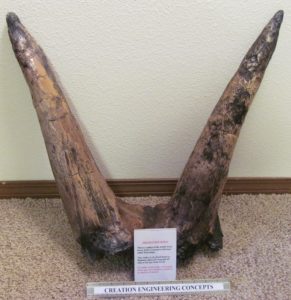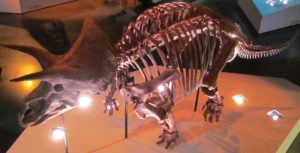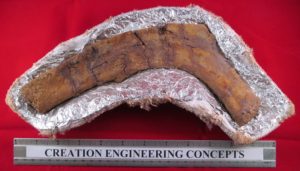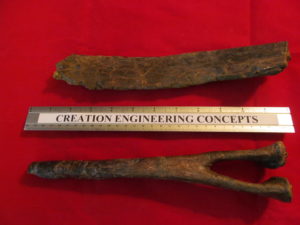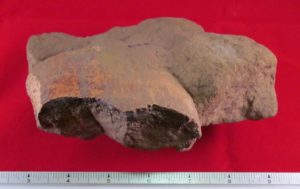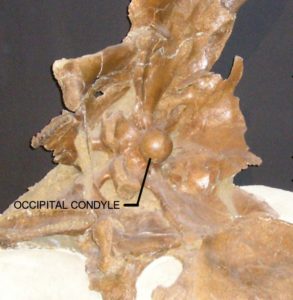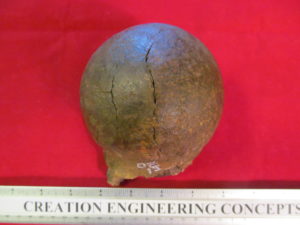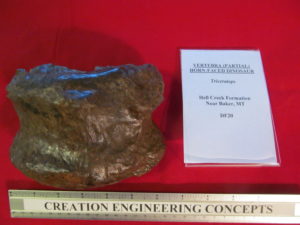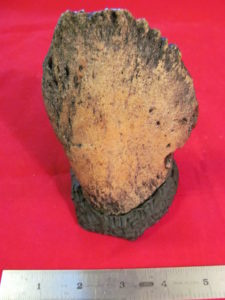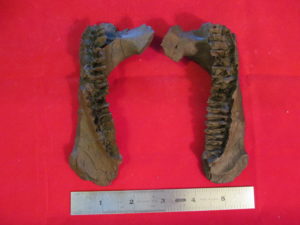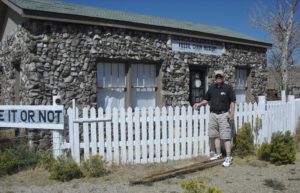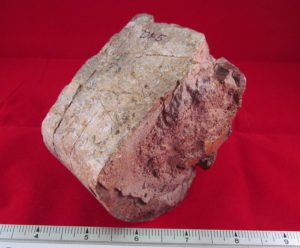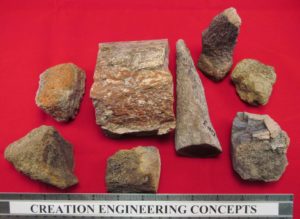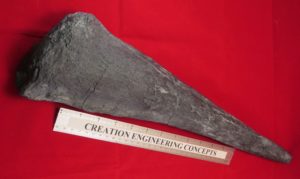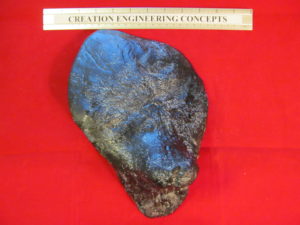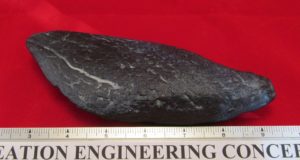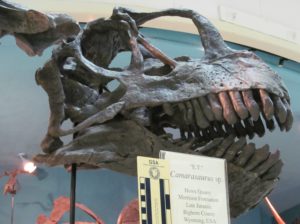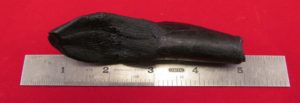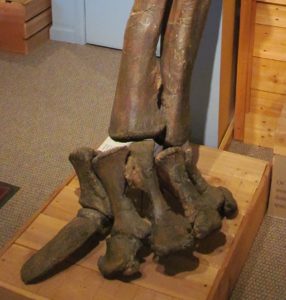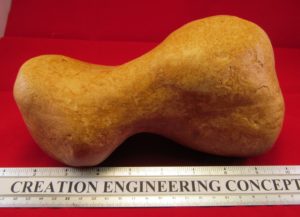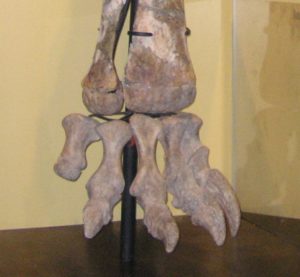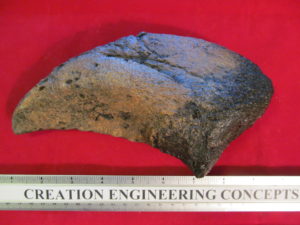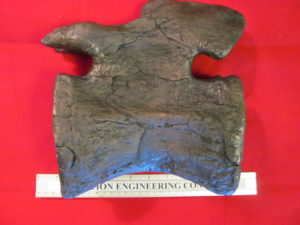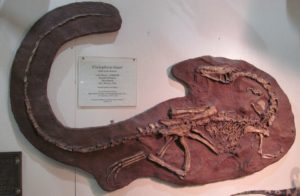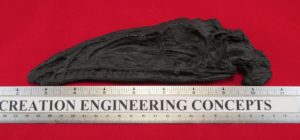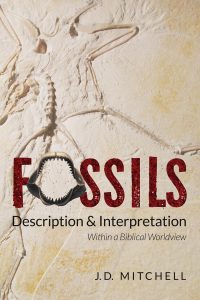All fossil images and descriptions ©2017 all rights reserved. Contact us for permission policy.
FOR ILLUSTRATIONS OF THE DINOSAUR KINDS CLICK HERE.
Dinosaur Compsognathus
Description: Cast plate is 10 3/4″ wide X 12 3/4″ high. Replica Compsognathus is frozen in the typical “dead dinosaur” pose with its neck bent back over its body. Tail extends about 7″ from the body.
Location: Solnhofen strata of Germany.
Interpretation: This small dinosaur fossil, which was about the same size as Archaeopteryx, was found in the same Solnhofen limestone strata as Archaeopteryx. There are a number of skeletal similarities between Compsognathus and Archaeopteryx, but the lack of any indication of feather imprints in Compsognathus has resulted in the two being considered entirely different life forms by most paleontologists.
Notice that this fossil is in the “opisthotonic” death pose in which quite a few articulated dinosaur fossil skeletons have been found in the rock record. One explanation for this posture, also seen in several Archaeopteryx specimens, is that muscle spasms from failure of the central nervous system at the time of death are the cause. At any rate, it seems clear that the pose is frozen in the rock and the animal was buried rapidly by tons of water-laden sediments. This matches the biblical explanation that everything in the Genesis Flood that had the breath of life in its nostrils (i.e., all land animals) died unless they were on the ark with Noah.
Archaeopteryx is an animal that J.D. Mitchell has been studying for over a decade. For much more information on Archaeopteryx click HERE.
#DR17
Dinosaur Furculas
Description: The replica Allosaurus furcula (lower) is a flat ‘V’ shape with an overall length of eleven inches around the inside of the curve. At maximum cross-section it measures 1″ X 1 1/2″. At each end of the furcula is a facet for contact with the shoulder blades. The image above the two furculas shows the typical reconstruction of a Tyrant Bipedal dinosaur chest with the location of the furcula marked.
The replica Tyrannosaurus furcula (top) is boomerang shaped with an overall length around the inside curve of 11 1/2″. At maximum cross-section it measures 1 1/2″ X 1 1/2″. The furcula has facets on each end that are less defined than in the Allosaurus furcula. The boomerang-shaped furcula of Archaeopteryx corresponds closely to that of the Tyrant Bipedal dinosaurs like these two, but not to that of flying birds.
Location: Allosaurus from the Cleveland-Lloyd quarry of Utah. Tyrannnosaurus Western USA. Reconstruction at Houston Museum of Natural History.
Interpretation: Until fairly recently, furculas were thought to be found only in birds. Therefore, evolutionists assumed the London specimen of Archaeopteryx with a furcula was an indicator that it was a bird or on the way to evolving into a bird. It is now known that every skeletal characteristic of Archaeopteryx closely matches the design of Tyrant Bipedal (theropod) dinosaurs. The only remaining characteristic that is bird-like are the feather imprints found in a few of the Solnhofen limestone fossils.
#DR20 & DR24
Dinosaur Brain Endocasts
Descriptions: The Allosaurus endocast (top) is 8 1/4″ long X 4 3/4″ high X 2 3/8″ thick. The Tyrannosaurus endocast (lower) is 7 1/4″ long X 2 3/4″ wide X 2 1/4″ thick. Both endocasts are thought to be from adult animals. Notice that the Allosaurus endocast is larger than the Tyrannosaurus even though larger fossil skulls have been recovered from Tyrannosaurus remains. Both dinosaurs are categorized as Tyrant Bipedal created kind by the author.
Location: Both from the western USA.
Interpretation: An endocast is the result of infilling the brain cavity of an animal’s skull. This infilling can be natural where the cavity is filled with fine grained sediments associated with the fossilization process. Or, scientific endocasts can be made from the artificial infilling by researchers to obtain a cast that uses the skull itself as a mold.
One assumption here is that the brain cavities reflect the actual sizes of the brains. In fish the brain may fill as little as fifty per cent of the brain cavity. In crocodiles and mammals the brains almost completely fill the skull cavities. Since dinosaurs are similar to crocodiles and mammals, let us assume that the endocasts above do realistically represent casts of the brains for these two individuals. Does this mean that Allosaurus was smarter than T-rex?
This is unlikely because it is very difficult to make these endocasts since the skulls are usually badly damaged or crushed, and if they have natural endocasts they are nearly impossible to remove from the skulls. These two endocasts appear to be examples of variation within the Tyrant Bipedal kind. Using biblical presuppositions we can believe that God designed these brains to be the perfect size, design, and construction to allow the animals to operate and adapt as needed while living on the earth.
#DF11 & DF12
Tyrant Bipedal Dinosaur Teeth
Description: All three are replica teeth from Tyrant Bipedal dinosaurs. The specimen in front with the long root (DR19) is from a Tyrannosaurus. The specimen in upper left with a jaw fragment (DR1) is also from a Tyrannosaurus. The smaller replica is from an Allosaurus (DR32). DR19 is 11″ long around the curve X 2 1/8″ maximum width X 1 3/8″ maximum thickness. DR19 tooth less the root is 3 1/4″ long. DR1 is 6″ long X 1 3/4″ maximum diameter at its base. DR32 tooth less the root is 2 1/8″ long.
Location: All from the western USA.
Interpretation: All Tyrant Bipedal dinosaur teeth are quite similar from genus to genus. The Tyrannosaurus and Allosaurus teeth above have similar geometry and comparable grooves caused by the crowns of erupting teeth below them. The main difference is in the size, which can be explained by the assumed age difference between the two specimens where one is an adult and the other a juvenile.
According to evolutionary theory, these two genera were on earth millions of years apart and so are only related in some deep-time evolved manner. The biblical creationist has an entirely different interpretation. Since both Tyrannosaurus and Allosaurus fossils are in the rock record as a result of the worldwide Flood, they lived at the same time. They were created along with the other land animals and man on Day Six of God’s creation as explained in the Bible. At the time of the fall, God instituted the curse, and for the 1,600 year period from the fall to the Flood animals, including dinosaurs, developed variations within the kinds (as allowed by their DNA) that are seen today in the fossils. These variations are not macroevolutionary changes from one created kind to another kind. Therefore, Tyrannosaurus and Allosaurus are both of the same Tyrant Bipedal created kind.
Dinosaur Foot Claws
Description: All are replicas. Claw at left (DR4) is 9″ long around the curve X 3 3/8″ high at the base X 3 3/8″ wide at the base. DR4 is from a Tyrannosaurus. The center foot is from genus Othnielia (DR25) and the claw on the longest toe is 1 1/2″ long around the curve X 3/8″ high at the base X 1/2″ wide at the base. The right hand foot is from Nanosaurus (DR9) and its longest toe is 1″ long around the curve X 1/4″ high at the base X 5/16″ wide at the base. Othnielia and Nanosaurus are two genus names for the same Bipedal Browser dinosaur.
Location: Western USA.
Interpretation: The Bipedal Browser dinosaurs such as Othnielia had teeth that indicate they were plant eaters at the time of the Flood. The Tyrant Bipedal dinosaurs such at Tyrannosaurus left evidence that indicate they were carnivorous at the time of the Flood. Yet the claws on their feet were very similar in design. For what purposes did dinosaurs use their claws?
At the time of the creation the Bible tells us that all animals and mankind ate only plants (Genesis 1:29). Therefore, we can know that an original purpose for dinosaur claws was not to tear the flesh of other animals. That use came only after the fall and the institution of the curse by God. In the beginning the claws of all animals were designed primarily to protect the toes and help with the harvesting and ingestion of plant matter. The claws would have also been helpful for nest building.
Dinosaur Femur Bones – Allosaurus
Description: The replica Allosaurus femur (DR34) is 9 1/2″ long. At the center of the shaft the bone is about 7/8″ diameter. The maximum bone width at the knee joint (left end) is 1 7/8.” The previous image is of a display of ten Allosaurus femur bones of various sizes.
Location: Cleveland-Lloyd Dinosaur Quarry in Utah.
Interpretation: Since the femoral head is 90 degrees to the centerline of the bone shaft we can deduce that the Allosaurus walked with its legs directly under its body.
At the Cleveland-Lloyd quarry are more than 12,000 individual dinosaur bones that have been discovered. The bone bed map for the quarry shows that these bones are completely disarticulated and represent a number of different dinosaur kinds. The situation corresponds to a biblical creationist interpretation that the quarry is a true fossil bone jumble and exists as a result of the Genesis Flood cataclysm.
Many bones from Allosaurus have been recovered from the quarry including a large number of femurs. Some of the femurs are shown in the figure above. Notice that there is variation in size as well as in the detailed formation of the bones. It seems reasonable to assume these femurs represent gender and age dimorphism, as well as general variation within a kind, over the 1,600 years from the time of the fall to the onset of the Flood. The replica juvenile femur DR34 is about 1/5 the length of the largest Allosaurus femurs recovered so far.
It is the practice of those recovering the bones at Cleveland-Lloyd to depict all of the bone found there as being black. So they paint them all black when displayed. In reality, the bones are in the rock close to the same color as the matrix which is a brownish-gray color. By painting all the bones black, cast replica bones can be used along with real bones in skeletal reconstructions. Not all museums paint their dinosaur skeletal reconstruction components black, but most do choose a particular color common in their displays, with shades of brown and gray being other popular colors.
Dinosaur Femur Bones – Camarasaurus
Description: The Long-Necked Boxy-Headed dinosaur replica cast femur is 5′-6″ long and about 9″ X 5″ in cross-section at the middle where it is the smallest. The image above is of a complete Camarasaurus leg reconstruction in the Royal Tyrrell Museum in Alberta, Canada.
Location: The state of Utah probably the Morrison formation.
Interpretation: Examples, besides Camarasaurus, of other dinosaur genus names of the same created kind found in North America are Brachiosaurus, Cedarosaurus, Paluxysaurus, Sauroposeidon. These animals are among the largest that have ever lived and therefore needed huge femur bones to support their tremendous weight!
The Bible in chapter 40 of the book of Job describes Behemoth which was likely a dinosaur of the long-necked created kind. There are many other evidences that indicate that dinosaurs were taken onto the ark with Noah and lived near man until their extinction or near-extinction. Reports from remote locations throughout the earth influence many to believe that some dinosaur kinds are still alive yet today.
#DR41
Allosaurus Radius Bones
Description: The pathological (top) replica radius is 6 3/4″ long and the thickened callus on it is about 1 1/2″ X 1 1/2″. The normal replica radius bone is 7 1/8″ long X about 3/4″ diameter at the midpoint.
Location: Cleveland-Lloyd Dinosaur Quarry in Utah.
Interpretation: Paleopathology is the study of diseases and injuries in fossils. More than a few dinosaur fossils have been discovered with these defects. Any fossil that shows signs of pre-death disease or injury is called “pathological.”
The shape of the two radius bones above tell us that they are from the left arms of two different animals. The left ends of the bones are shaped to connect to the humerus bones. All around the pathological bone, rough and porous bone formed a callus after it was broken and as it healed. We can expect that this was very painful for the Allosaurus and it would not have been able to use its left arm until it healed. Since the healed bone is crooked the dinosaur would have been “crippled” and the callus may have rubbed against the other arm bone, the ulna.
The Bible tells us that there was no death, disease or suffering before the fall. Death came from man’s sin, so that means that dinosaurs found in the rock record (even those with pathologies) were buried in the Flood and became fossilized after the fall. The Allosaurus broke its arm sometime during the 1,600 year period between the fall and the Flood. (Of course, some dinosaurs were taken onto Noah’s ark and were not buried in the Flood. Their bones and the bones of their descendants were seldom if ever fossilized, according to the biblical creationist hypothesis.)
#DR35
Edmontosaurus Toe Bones
Description: The larger fossil toe bone would be located adjacent to the metatarsal bone in the foot of the dinosaur and is 2″ long X 2 1/2″ wide. The next adjacent phalange is 1″ long X 1 7/8″ wide. The size and color of the fossils indicate that they may be from the same foot on the same dinosaur. The image above is of the Edmontosaurus foot reconstruction at the South Dakota Museum of Geology.
Location: Lance Creek formation of Wyoming.
Interpretation: These two figures of foot and toes bones illustrate the difficulty involved in accurately reconstructing extinct vertebrate animals from their fossilized remains. Usually the bones are found in bone jumbles and numerous components of a complete animal are found to be missing. For example, the author has seen a number of reconstructions of the Edmontosaurus foot and each one depicted the amount of toe splay and the distance between phalanges differently. Without having a live animal to look at it is impossible to determine these details with certainty from fossil bones alone.
#DF9 and DF10.
Duck-Billed Dinosaur Vertebrae
Description: The replica lumbar vertebra (painted black) in the two images above is from an Edmontosaurus dinosaur and is 11″ tall X 8″ wide X 3″ thick. It has the vertical neural spine, two nearly complete transverse processes, and a clear neural canal which is the hole for the spinal cord. This vertebra was recovered along with three other lumbar vertebrae and several other bones of an incomplete disarticulated skeleton estimated to represent about sixty per cent of the animal.
The top image also shows a fossilized vertebra from a Duck-Billed kind of dinosaur and is missing its neural spine and transverse processes, but it is obvious where they originally were solidly attached to the centrum. The fossil vertebra is 4″ in diameter X 3″ thick and is similar enough in design to be from the same genus of dinosaur as the more complete replica.
In the lower image the replica vertebra is compared to another Duck-Billed dinosaur partial vertebra which is very unusual in that a portion of the spinal cord has been fossilized. This vertebra is 4″ wide X 3 3/4″ long X 7 1/4″ tall. The spinal cord section is 1 1/8″ diameter X 3″ long.
Location: Replica from the Hell Creek formation of southern North Dakota. Both real fossil vertebrae from the Hell Creek formation of Montana.
Interpretation: The excavators of the bones from which the replica cast vertebra was made explained the fossilization and recovery of the partial Edmontosaurus as a many “millions of years” process. Each of the bones was in a bone jumble and was broken or distorted. The two partial vertebra are also damaged. Local flooding and other uniformitarian geological actions can be used to explain these fossils over deep time, but the worldwide Flood just 4.500 years ago is a more satisfying explanation to an open and logical mind. It is very difficult to imagine the spinal cord section becoming fossilized through any slow evolutionary process.
#DR28, DF1 and DF19.
Duck-Billed Dinosaur Fossilized Tendon
Description: The ossified fossil tendon is encased in a sandstone matrix about 2 3/4″ wide X 4″ long X 1 3/8″ thick. The section of tendon itself is 3/8″ wide X 1 15/16″ long. Intratendinous ossification is somewhat common in Duck-Billed and some other kinds of dinosaurs. Ossification is the process of tissue turning into bone. The top image is of the reconstruction of the tail of the Tenontosaurus dinosaur that had bundles of ossified tendons that extended along the back and down the tail.
Location: The Two Medicine formation of Montana.
Interpretation: The word “ossification” is generally applied to the process wherein bones are formed in living animals. A fossil is defined as, “remains or traces of life usually found embedded in sedimentary rock.” What we have here is a dinosaur fossil that consists of a tendon that turned into bone prior to the death of the animal. This is somewhat common in some dinosaurs and some birds while they are alive. It is thought that the ossified tendons stiffened the tail and counterbalanced the torso when the dinosaurs walked on their hind legs.
This leads evolutionists to believe that ossified tendons in both dinosaurs and birds from the rock record means that they have a common ancestor. They also might say that the dinosaurs “developed” the ossified tendons for the advantage that they afforded them. But, this does not follow from biblical presuppositions. The evidences are compatible with the idea that there was a Common Designer for all animals and He could use a number of different combinations to design a myriad of lifeforms with capabilities to do what they needed to do to survive.
#DF21
Duck-Billed Dinosaur Teeth
Description: The Edmontosaurus replica tooth row is 2 1/2″ wide X 2″ tall X 5 1/2″ long. The loose replica Edmontosaurus tooth is 2″ long X 1/4″ wide. The tooth row looks to be from a larger dinosaur than does the loose tooth. The image above is of an actual fossil Edmontosaurus jaw at the Museum of the Rockies showing it tooth battery.
Location: Western North America.
Interpretation: In the Duck-Billed dinosaurs the teeth were made up of closely packed rows of self-sharpening teeth. That design allowed for the teeth surfaces to be renewed as they were worn. These teeth would be good for shearing and grinding tough plant material.
According to evolutionary theory, all dinosaurs have a common ancestor and the various tooth designs evolved over millions of years from that unknown ancestor. A much more satisfactory hypothesis is that the different tooth designs were created in the beginning according to the foreknowledge of the Ultimate Designer.
#DR29 and DR30.
Dinosaur Skin Imprints
Description: The Duck-Billed dinosaur replica skin imprint on the left is 3 3/8″ wide X 5 3/4″ long. The largest scale is 1/4″ X 3/8″ and the smallest scales are about 1/16″ square. The Horn-Faced dinosaur replica skin imprint on the right is 3 1/4″ wide X 4 3/4″ long. The largest scale is 2 1/4″ diameter and the smallest scale is about 5/16″ square. The colors of the replicas were chosen by the cast makers and no scientist really knows the color(s) of the skin of any dinosaur from the rock record.
Location: Hell Creek formation of Montana.
Interpretation: Because many evolutionists believe birds evolved from dinosaurs, it is important for them to assume that many dinosaurs had feathers. Therefore, the existence of feathers should be obvious in the dinosaur fossils.
As is clear in these two replicas, the skin of dinosaurs had scales similar to those found on today’s reptiles. The structure of feathers is extremely more complex than the structure of scales, so feathers could not have evolved from scales no matter how much time is allowed. While God could have, and may have, designed some dinosaurs with feathers, there is little real evidence for this in the few fossil dinosaur skin imprints that have been so far discovered.
#DR5 and DR12
FOR ILLUSTRATIONS OF THE DINOSAUR KINDS CLICK HERE.
Triceratops Horns
Description: Each replica Triceratops horn is 22″ long and the distance from tip to tip is 20.” At their base each horn is 4 5/8″ diameter and the distance between the horns where they connect to the skull is 4 1/2.” The skull segment section is 6 1/2″ wide X 14″ long.
Location: Western North America.
Interpretation: Just prior to the Flood, we can interpret the various frill designs and horn arrangements in Horn-Faced dinosaurs to possibly have been adapted for defensive purposes. Soon after creation, before the fall, perhaps the horns were used for various food gathering purposes since there would have been no need for defense in the perfect creation prior to man’s sin. Another possible use during both periods could have been for attracting mates.
There are about twenty genus names currently assigned by secularists to the Horn-Faced dinosaurs because of the variations in head adornments that have been discovered. The skeletal design in all these genera is otherwise pretty much the same, consequently the differences in horns and frills is likely due to variations within a single created kind. These variations came to be due to age and gender differences and genetic adaptations that happened after the institution of the curse and prior to the Flood.
#DR2
Triceratops Ribs
Description: Top image of the three is of a complete Triceratops skeletal reconstruction showing how the ribs connect to the vertebrae of the animal. Middle image is a rib section from a Triceratops dinosaur displayed in a plaster jacket that was used to protect the fossil during recovery. Bottom image is of another Triceratops rib section along with a Triceratops tail chevron bone.
Location: All from the Hell Creek formation of Montana.
Interpretation: The fossil rib sections look to be from adult specimens and were collected from different locations at different times. The skeletal features of Triceratops, Styracosaurus, Chasmosaurus, Torosaurus and other Horn-Faced dinosaurs were all very similar with genera differences mostly in the skulls. This lends credence to the biblical creationist idea that all were just one created kind.
#DF7, DF17 and DF18.
Triceratops Fibula
Description: The partial Triceratops fibula bone is 3″ wide X 1″ deep X 2 1/4″ long encased in a fine sandstone matrix. The exterior of the bone is permineralized to a thickness of 1/8″ to 3/8″ thick and the rest of the bone is missing. This was identified by the paleontologists at the Black Hills Institute in Hill City, South Dakota.
Location: Hell Creek formation.
Interpretation: Fossil bones are found in a number of different conditions of preservation from nearly 100 percent original bone to 100 percent totally permineralized. They are found in mudstone, sandstone, limestone and every combination of minerals that make up the earth’s sedimentary layers. Yet, where do we see animal bones being fossilized today? Not in lake beds, rivers, or oceans as hypothesized by secularists. It makes more sense that most fossil bones, especially dinosaur bones, were the result of the special conditions of the one-time global event at the time of Noah as described in Genesis.
#DF4
Triceratops Occipital Condyle
Description: The Triceratops occipital condyle is totally permineralized and is nearly spherical except where it was connected to the skull of the animal. It measures 4 inches in diameter and is about 4 1/2″ thick perpendicular to its attachment area. The image above it shows another Horn-Faced dinosaur skull with the occipital condyle still connected.
Location: The Hell Creek formation of eastern Montana.
Interpretation: The ball and socket joint is used in many mechanical and other applications where a more universal relative motion between two components is required. As with most other applications of man’s mechanical engineering, God was the first to use it! This ball and socket design was used to connect the skull to the end of the vertebral column in not only the Horn-Faced kind, but most all other dinosaurs as well. The ball was located halfway between the front of the skull and the back of the skull in Triceratops, which allowed the head to be balanced. The head was very heavy, but was connected by heavy neck muscles.
#DF15
Triceratops Vertebra
Description: The partial Triceratops vertebra is 6″ wide X 4″ long X 3 1/2″ thick.
Location: The Hell Creek formation near Baker, Montana.
Interpretation: This specimen provides an idea of the size of the vertebral column for the adult Horn-Faced dinosaurs, but has been stripped of its processes and ripped away from the rest of the animal by the severe actions of the global Flood. The fossils of the largest Horn-Faced dinosaurs so far discovered indicate that the adult animals were about the size of a full-grown elephant.
#DF20
Triceratops Toe Bone
Description: Since the large hind and forelimb toe bones (unguals) are very similar in the Horned-Faced dinosaurs, it is not possible, when found separated from the rest of the limb, to know which foot the toe is from. This replica cast is sitting in a black-colored stand to allow for a better view of the bone. The hoof-like toe is 4 1/2″ long X 3 1/2″ wide X 2″ thick.
Location: Western North America.
Interpretation: In order for Triceratops to be able to support its huge weight (perhaps up to 13 tons), it was designed with large feet like the rhinoceros to spread out the load. It probably took advantage of its hooves in ways similar to hoofed animals of today.
#DR37
Baby Triceratops Dentaries
Description: These two bones are replicas of the two dentaries that made up the lower jaw of a baby Triceratops. They are each about 5 1/2″ long X 2 1/2″ high X 1″ thick. The bones are oriented to best display the design for the teeth sockets.
Location: Hell Creek formation, near Jordan, Montana.
Interpretation: In the quarry where the fossil bones were found were discovered a few parts of a baby Triceratops. Included were these two dentaries, the right one complete and the left partial. Also found was a complete 6 1/2″ long humerus bone. Using these parts to estimate the size of the baby, paleontologists calculated it to be less than three feet long with a skull less than a foot long.
Most of the dinosaur fossils that have been found in the rock record are of adult animals as baby parts are much more scarce. That fact matches up to the idea that the animals were buried in the Flood with the larger ones more likely to survive the longest and therefore be uncovered first by erosional actions.
#DR36
Dinosaur Leg Bone Section
Description: The bone section is totally permineralized so that it is extremely hard and very heavy, weighing three pounds. The bone marrow has been largely replaced by the red mineral jasper. The specimen cross-section is ‘D’ shaped and is 4 1/8″ wide X 3″ high. By extrapolation it can be estimated that the original cross-section of the bone was about 5″ wide X 3 1/4″ high. The bone section is 3″ long. The photo above is of a cabin that was made of nearly 6,000 individual dinosaur bones similar to the leg bone.
Location: Cabin is located near to Como Bluff in Wyoming. Bone from Utah.
Interpretation: The characteristic D-shaped cross section and the size of the bone indicate it is likely from a fairly large dinosaur leg bone. Hardened fossil dinosaur bones are often found broken into pieces like the specimen as a result of the hydraulic, volcanic, and tectonic actions of the Genesis Flood; and the subsequent geologic forces and weathering applied to them as they erode out of the layers they were initially formed in.
#DF5
Dinosaur Bone Marrow
Description: The cone-shaped specimen in the center of the photo is 1 1/2″ diameter at the base X 5 1/2″ long. The bone to the left was previously described. These two pieces are very dense. The other dinosaur bone pieces are of varying densities, but less than the first two.
Locations: Cone-shaped specimen is from the North Saskatchewan River, Edmonton, Alberta. The largest specimen is from Utah. The remaining six are all from the Hell Creek formation of Montana.
Interpretations: The bones of living animals are one-third water, have blood vessels going in and out, have nerves that can feel pressure and pain; and certain bones contain marrow which produces blood cells. The bone marrow is contained inside a wide layer of strong compact bone and is a spongy material.
When one is looking for fossils in the field, one way to differentiate bone from rock is to look for the characteristic bone marrow morphology. The density and color of fossilized bone marrow is determined by the type and extent of the minerals that have replaced the original tissues of the bone. However, in most cases the characteristic “spongy” look of the fossil is what identifies the marrow.
Bones found lying around in nature lose the interior marrow component long before the harder exterior portion deteriorates. Therefore, fossilized bone marrow is always an indication of complete and rapid burial. The biblical creationist understands that the uniformitarian scenario for fossilization, one of slow burial over long periods of time, does not match reality in any way. Vertebrate bones of today and yesterday have a common design for marrow because of the work of the Common Designer.
#DF3
Stegosaurus Tail Spike
Description: The replica tail spike is 20″ long X 2 1/2″ thick X 5″ wide at its base. It is 3/4″ wide X 1/2″ thick at the tip. The numerous grooves in the surface of the spike were probably for blood vessels.
Location: Cleveland-Lloyd Dinosaur Quarry in Utah.
Interpretation: Plate-Backed dinosaur reconstructions are usually depicted with four of these tail spikes at or near the end of the tail. The spike from which this replica was made is from a quarry where hundreds of dinosaur bones have been uncovered in a huge bone jumble.
The biblical creationist agrees that these spikes were undoubtedly used for defense by these dinosaurs after the fall. There is no agreement for how the jumble came to be however. The evolutionist must assume some sort of local flood action while the biblical creationist would say the bone jumble is a result of the worldwide Flood.
#DR31
Stegosaurus Bony Tail & Neck Plates
Description: The lower image is of a replica bony plate from the tail of a Stegosaurus. It is 2 3/4″ high X 7 1/4″ long X 1 9/16″ thick at the base. Its cross section is triangular in shape. The largest groove in the surface is 1/16″ wide X 1/16″ deep X 3″ long. The upper image is of a replica Stegosaurus neck plate and is 10″ tall X 6 3/4″ wide X 4 3/4″ thick at the base.
Location: Cleveland-Lloyd Quarry in Utah.
Interpretation: The plates toward the tail were the smallest and the ones on the center back were the largest. The grooves indicate a horny sheath my have covered the plates and holes at the base allowed for blood to be pumped into the plate. The plates were anchored to the back of the animal in two parallel rows.
These bony plates were probably for heat regulation and/or to attract mates. After the fall, the plates undoubtedly served defensive purposes as well. Among the dinosaurs the Plate-Backed kind exhibited some of God’s most unique designs.
#DR33 and DR39
Camarasaurus Teeth
Description: The Camarasaurus replica tooth is 4 1/8″ long overall X 1 1/4″ wide X 15/16″ thick. The tooth root is 2″ long X 3/4″ wide X 7/8″ thick. The upper image is of a Camarasaurus skull with a good view of its teeth.
Location: Morrison formation in Utah.
Interpretation: An analysis of the teeth and skull from the Long-Necked Boxy-Headed kind of dinosaurs has resulted in an understanding that the teeth were designed to clip off plant matter using a chomping action. The vegetable matter would then go directly into the animal’s digestive system since there were no grinding teeth available for chewing. These dinosaurs probably had gizzards with stones inside to help with digestion. A biblical creationist hypothesis is that this kind of dinosaur did not change very much over the 1,600 years from the time of creation to the Flood.
#DR26
Brachiosaurus Toe Bone
Description: The massive replica toe bone is 9″ long X 4 1/2″ wide X 4 5/8″ maximum height.
Location: Morrison formation in Colorado.
Interpretation: Most reconstructions show the toe bones of these large Long-Necked Boxy-Headed dinosaurs in a near vertical position, as seen in the image above. This foot design is similar to the foot design of today’s largest land animal, the elephant. Elephants walk on their toes and have a large fatty footpad to distribute their large weight on the ground. Long-Necked dinosaurs also grew to be very large and heavy, so it makes sense they would have had a similar foot design to the elephants.
Many biblical creationists believe that a Long-Necked dinosaur was the Behemoth described in chapter 40 of the book of Job in the Bible. God’s description of Behemoth closely matches our current understanding of the construction of a Long-Necked dinosaur. God’s description of Behemoth does not correlate with the comments often offered that Behemoth was an elephant or a hippopotamus. If you doubt this, just ask an uninterested party to describe an elephant or a hippo and see if any of the defining characteristics of these animals match those of Behemoth.
#DR13
Camarasaurus Toe Claw
Description: The replica Camarasaurus toe claw is 8 1/2″ long X 4″ wide X 2 1/8″ thick. A Camarasaurus reconstructed complete foot is shown in the image above.
Location: Cleveland-Lloyd Quarry of Central Utah.
Interpretation: With claws like these one could imagine the animal digging large holes in the earth or even defending itself against attack!
#DR40
Apatosaurus Caudal Vertebra
Description: The replica Apatosaurus caudal (tail) vertebra is 9 1/4″ long X 9″ tall X 3 1/2″ thick.
Location: Wyoming
Interpretation: Apatosaurus was a Long-Necked Slender-Headed kind of dinosaur whose fossils indicate may have grown to be up to 90 feet long. This kind is another candidate for the Behemoth described by God in Job chapter 40.
Due to the lack of discovered fossil skulls the dinosaur with the genus name Brontosaurus was fitted with an incorrect skull when first reconstructed for display. Therefore, Brontosaurus was later superseded by the genus name Apatosaurus that had been assigned earlier than Brontosaurus for the correct reconstruction. For long-time dinosaur lovers it is difficult to give up the Brontosaurus name that was synonymous with dinosaur for so many years.
#DR38
Coelophysis Skull and Skeleton
Description: The replica cast Coelophysis skull and cervical segment are about 8 1/2″ long. The skull is 2 3/8″ high X 1″ thick at the top and 3/8″ thick at the bottom. The skull was smashed nearly flat prior to fossilization. The largest teeth are 5/16″ long and the eye socket is 1 1/4″ diameter. The cast replica of a complete Coelophysis skeleton above is at the Black Hills Institute in South Dakota.
Location: Kayenta formation of New Mexico at Ghost Ranch.
Interpretation: The dinosaur Coelophysis was a Lithe, Fast Running created kind and is mostly known from more than one hundred fossilized skeletons discovered in 1947 at Ghost Ranch in New Mexico. The skeletons are in a bone jumble described by secular scientists as having been caused by a giant flood!
To the biblical creationist the discovered conditions of the large number of dinosaur fossils, some found in the death pose seen in the skeleton above, do indeed indicate rapid burial in a giant flood.
Secular science has loosened its grip on some of the uniformitarian ideas once held, but still can never accept the truth of the Genesis Flood because to do so would destroy its atheistic worldview. Geologic catastrophe is now accepted in most secular geology circles, but the great cataclysm carefully described in several chapters of the Bible cannot be accepted due to the hold of naturalism on so many.
#DR8
FOR ILLUSTRATIONS OF THE DINOSAUR KINDS CLICK HERE
ORDER THE FOSSIL BOOK:
